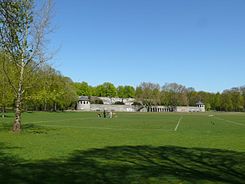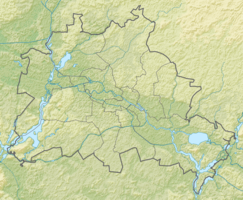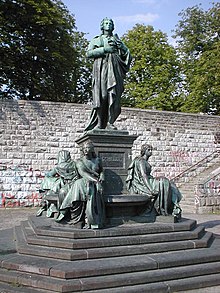Schillerpark (Berlin)
| Schiller Park | ||
|---|---|---|
| Park in Berlin | ||

|
||
| Schillerpark view of the bastion | ||
| Basic data | ||
| place | Berlin | |
| District | Wedding | |
| Created | 1909-1913 | |
| Surrounding streets | Dubliner Strasse, Bristolstrasse, Barfusstrasse, Edinburger Strasse, Ungarnstrasse | |
| Buildings | Terrace system | |
| use | ||
| User groups | Leisure time , children, foot traffic | |
| Park design | Friedrich Bauer | |
| Technical specifications | ||
| Parking area | 28.4 ha | |
|
52 ° 33 '25 " N , 13 ° 21' 8.2" E
|
||
The Schillerpark is located in Berlin 's Wedding district ( Mitte district ) and was laid out between 1909 and 1913. The first plans for the construction of a park on the root mountains and their environment existed since 1898. The Schiller Park is due to the then novel generous and open park planning (as opposed to older and cramped Friedrichshain park ) as the first social requirements appropriate Volkspark Berlin and Germany. The Schillerpark is under protection as a garden monument .
Under the name of Siedlung Schillerpark, there is a residential area connected to the park in the English Quarter , which was built in the 1920s according to plans by the architect Bruno Taut .
history
As early as 1898, the first considerations were made to create a park on the ridge of the Wurzelberge and its surroundings. This area is a former dune area in a wind-exposed location (eight windmills were operated between Müllerstrasse and Schäferstrasse in 1810), and the drifting sand was the cause of constant nuisance for residents. The discussions about the park's extension and design lasted for several years. In 1903 the city council was finally able to define the boundaries of what would later become the park and authorize the magistrate to purchase the required land. On the 100th anniversary of the death of Friedrich Schiller in 1905, the poet became the namesake of the future park.
In 1907 a design competition was advertised for which 105 works were submitted. Among these, the design by the Magdeburg garden architect Friedrich Bauer (1872–1937) under the title “Joy of beautiful gods spark” was selected and rewarded with 5000 marks. Bauer designed a park which, according to his conception, was "primarily dedicated to the physical and mental relaxation of the city dwellers" and offered the "opportunity for walks in the fresh green, to play, to exercise, to enjoy nature that is often lacking". In addition, the park should "give those who desire it the possibility of serious contemplation, quiet solemnity and, last but not least, full joy in exquisite splendor beauty". Bauer's planning concept envisaged generous lawns as play areas and sunbathing areas with forest-like strips of wood to protect them. A terrace system should act as a central reference point, regular avenues and a rose garden should further subdivide the area. In contrast to older parks (such as the Volkspark Friedrichshain), which were designed according to stately models and are more reminiscent of botanical gardens, the Schillerpark should no longer passively look at nature, but rather active sporting activities in the fresh air and in the light of the sun Stand in the foreground. The Schillerpark is therefore the first in the series of modern public parks.
Work on creating the park lasted from 1909 to 1913. Most of the trees that were planted were native varieties such as oak , elm , poplar and linden . The shire oak - the first tree planted in the park - was procured from Schiller's birthplace in Marbach am Neckar . A cast of the Schiller monument by Reinhold Begas in front of the theater on Gendarmenmarkt was set up on the terrace in the park, known as the bastion .
In addition to sports, games and recreational opportunities, the pupils' lawn with the integrated terrace area served as a political meeting place and rally.
On old maps you can see that today's Schillerpark is traversed by two chains of hills, which are still recognizable today: The Barfusstraße divides the Schillerpark into two sections, north of the road are the Rehberge , south of the road the Wurzelberge . In this respect, the name Rehberge is not entirely correct for the nearby Volkspark: The chain of hills in today 's Volkspark Rehberge are the Leutnantsberge, which stretch in an easterly direction to the Rehbergen, but which are located in the area of today's Schillerpark.
The Schillerpark is one of the three largest parks in Berlin-Wedding and has largely been preserved in its original state, which is why it was included in the list of designated garden monuments as early as 1986.
Monuments
The Schiller Monument erected in 1941 is a copy of the Schiller Monument created by Reinhold Begas in 1869 . The original was on Gendarmenmarkt until 1935. The National Socialists used Schiller for their propaganda. It was not until 1940 - a year before the monument was erected - that the lavishly produced film Friedrich Schiller - The Triumph of a Genius came to the cinemas, in which Schiller came to the cinemas as a symbol of daring and the dawn of a new era. The erection of the memorial should also set an example in the resistant workers' district and also impress the students who exercise in the Schillerpark with German intellectual history. For the erection of the monument, the terrace of the Schillerpark was rebuilt. A well niche was closed, an ornamental gable was dismantled with it and another sculpture was dismantled. The sculpture "Ringer" by Wilhelm Haverkamp , created in 1906 and has been in the Schillerpark since the 1920s, was removed from its central location in Schillerpark and moved to a path in Rehberge Park . At the same time, the memorial for the Jewish entrepreneur and politician Walter Rathenau , which had become undesirable in the Rehberge Park, was melted down in order to obtain the material for the Schiller memorial from his material.
The bronze monument shows Schiller on a high base. As attributes he wears a laurel wreath and an ancient scroll, at his feet sit - depicted as female figures - poetry, drama, philosophy and cultural and intellectual history. A bronze lion head underneath the name plaque "Schiller" was stolen in August 2017.
Bomb attack
In August 2011, a bomb attack took place in the park, in which a man was seriously injured. The bomb was hidden next to a park bench in a plastic bag that the man had picked up. The perpetrator, who had planted a total of three bombs since 2007, was declared in May 2013 by the Berlin district court as not guilty at the time of the crime and was admitted to the closed psychiatry.
Data on the Schillerpark
- Size: approx. 29.4 ha
- Leisure activities: walking paths, playgrounds and sunbathing areas, playgrounds, paddling pool, toboggan slope
- Special facilities: three-tier limestone terrace with rose garden, chestnut grove and Schiller monument
- Legal status: Dedicated public green and recreational area, garden monument
- Period of origin: 1909 to 1913, extension from 1955 to 1957
- Landscape architect: Friedrich Bauer
- Transport connections: subway, several bus routes
literature
in alphabetical order by authors / editors
- Bettina Bergande: Playing in the Schillerpark - dealing with the historical concept, changes and today's requirements in terms of monument preservation . In: Die Gartenkunst 28 (1/2016), pp. 113–118.
- Stefanie Hennecke: German Ideologies of City and Nature: The Creation and Reception of Schiller Park in Berlin. In: Dorothee Brantz / Sonja Dümpelmann (eds.), Greening the City. Urban Landscapes in the Twentieth Century. Charlottesville / New York 2011, pp. 75–94.
- Rudolf Fischer: The Schiller Park in Berlin . In: Die Gartenkunst, No. 2/1911, pp. 37–40.
- Clemens Alexander Wimmer : Parks and Gardens in Berlin and Potsdam . 3rd edition. Nicolaische Verlagsbuchhandlung, Berlin 1989. ISBN 3-87584-267-7 , pp. 47–51.
Web links
- Entry in the Berlin State Monument List
- Schillerpark, Berlin: Year 1913 in the online exhibition 100 Years of Landscape Architecture by the bdla
Individual evidence
- ↑ Homepage District Office Mitte with information on the Schillerpark settlement; accessed on January 29, 2010 ( Memento of April 29, 2010 in the Internet Archive )
- ↑ Schillerpark, Berlin . Year 1913 in the online exhibition 100 Years of Landscape Architecture from the bdla . Retrieved March 27, 2014.
- ^ Straube's special card from 1903, in: Dettmer, Klaus: Wedding , 1988
- ↑ a b Wolfgang W. Timmler: Hitler's Hat - The Schiller memorial in the north of Berlin . In: Ingeborg Siggelkow (ed.): Memory culture and politics . Frank & Timme, 2006, ISBN 978-3-86596-057-3 , pp. 55 ff .
- ↑ Theft of a bronze plate from the Schiller Monument in Schiller Park
- ↑ Jörn Hasselmann: Man seriously injured by an explosive device in the park . In: Der Tagesspiegel from August 15, 2011, accessed on June 6, 2013
- ↑ Kerstin Gehrke: Bomb maker instructed in psychiatry . In: Der Tagesspiegel from May 3, 2013, accessed on June 6, 2013



